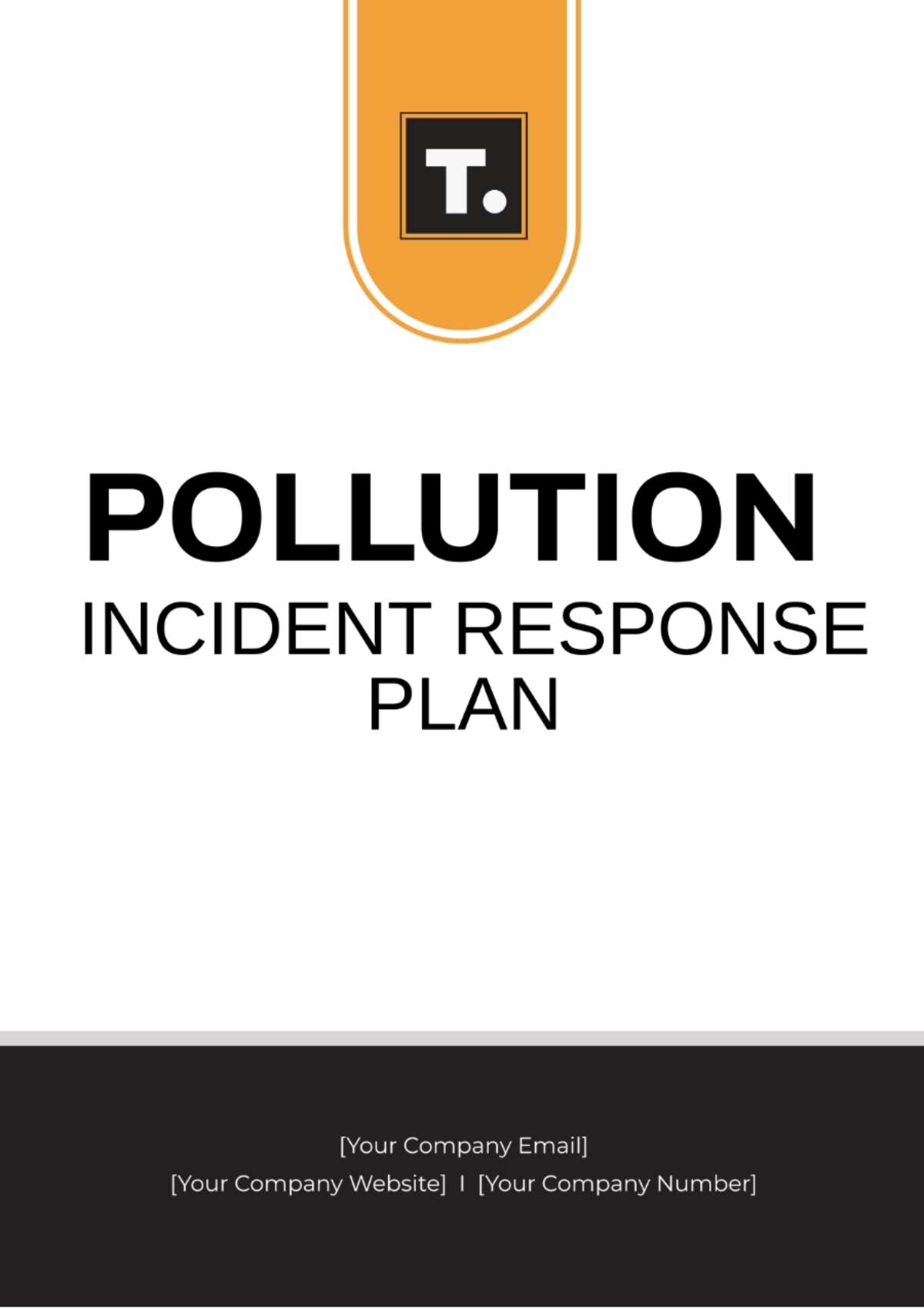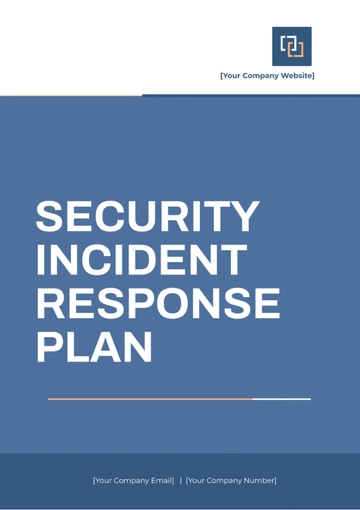Free Pollution Incident Response Plan

I. Introduction
This Pollution Incident Response Plan (PIRP) for [Your Company Name] outlines the procedures and responsibilities for responding to chemical spills or leaks at our manufacturing and industrial facilities. The plan ensures prompt and effective action to minimize the impact on health, safety, and the environment.
II. Purpose
The purpose of this plan is to:
Provide clear instructions for responding to chemical spills or leaks.
Protect employees, the community, and the environment.
Comply with local, state, and federal regulations.
Minimize damage and reduce recovery time and costs.
III. Scope
This plan applies to all personnel at [Your Company Name] facilities and covers all types of chemical spills or leaks, including:
Hazardous and non-hazardous chemicals.
Small and large spills.
Spills occur during handling, storage, or transportation.
IV. Roles and Responsibilities
A. Incident Commander (IC)
Directs the response operations.
Communicates with emergency services and regulatory authorities.
Ensures the safety of personnel and the public.
B. Response Team
Executes spill response actions.
Contains and cleans up the spill.
Conducts decontamination and waste disposal.
C. Safety Officer
Monitors and assesses hazards.
Provides safety briefings and PPE (Personal Protective Equipment) recommendations.
Ensures compliance with safety protocols.
D. Environmental Coordinator
Evaluates environmental impacts.
Coordinates with environmental agencies.
Oversees decontamination and remediation efforts.
V. Risk Assessment
Conduct regular risk assessments to identify potential chemical spill scenarios. Assess the severity and likelihood of spills and prepare mitigation strategies accordingly. Consider factors such as:
Chemical properties.
Storage and handling procedures.
Proximity to sensitive environments.
VI. Response Procedures
A. Initial Response
Alert and Alarm: Notify the Incident Commander and sound the alarm if necessary.
Evacuation: Evacuate the affected area if there is a significant risk to personnel.
Assess the Situation: Determine the type and extent of the spill.
B. Spill Containment
Use absorbent materials or spill kits to contain the spread.
Utilize dikes, booms, or other barriers if the spill is large or near water bodies.
C. Spill Clean-up
Follow specific clean-up procedures based on the chemical involved.
Use appropriate tools and PPE for safe handling.
Neutralize the spill if applicable.
D. Decontamination
Decontaminate affected surfaces and equipment.
Ensure personnel follow decontamination procedures to prevent secondary contamination.
E. Waste Disposal
Collect and label all waste materials properly.
Dispose of waste according to local, state, and federal regulations.
Maintain records of waste disposal.
VII. Communication Plan
A. Internal Communication
Utilize the specified communication channels that have been designated to coordinate internal activities and discussions.
B. External Communication
Ensure that regulatory authorities and emergency services are informed as necessary.
C. Public Communication
Ensure that accurate and precise information is disseminated to the public and media outlets through officially designated representatives who serve as spokespeople.
VIII. Training and Drills
Conduct regular training sessions for all employees on spill response procedures.
Perform periodic drills to test the effectiveness of the response plan.
Review and update training materials based on drill outcomes and feedback.
IX. Reporting and Documentation
Document all spill incidents, including response actions and outcomes.
Complete required regulatory reports and submissions.
Maintain records of all training, drills, and incident responses.
X. Plan Review and Maintenance
Review the PIRP annually or after significant incidents.
Update the plan to reflect changes in operations, regulations, or lessons learned from drills and incidents.
Ensure all personnel are informed of updates and trained accordingly.
XI. Appendices
A. Emergency Contact List
Include contact details for internal and external emergency contacts, such as:
Contact Role | Name | Phone Number |
|---|---|---|
Incident Commander | John Doe | 123-456-7890 |
Safety Officer | Jane Smith | 234-567-8901 |
Environmental Coordinator | Mark Johnson | 345-678-9012 |
Local Fire Department | N/A | 911 |
Environmental Agency | N/A | 987-654-3210 |
B. Spill Response Equipment List
Inventory of spill kits, PPE, and other response tools.
Location of equipment within the facility.
Equipment | Quantity | Location |
|---|---|---|
Spill Kits | 5 | Storage Room 1 |
Absorbent Pads | 50 packs | Warehouse |
Protective Gloves | 200 pairs | Safety Office |
Chemical Neutralizers | 10 containers | Chemical Storage Area |
Dikes and Booms | 4 sets | Loading Dock |
- 100% Customizable, free editor
- Access 1 Million+ Templates, photo’s & graphics
- Download or share as a template
- Click and replace photos, graphics, text, backgrounds
- Resize, crop, AI write & more
- Access advanced editor
Streamline your environmental compliance with Template.net's Pollution Incident Response Plan Template. Fully customizable and editable, this template ensures swift, accurate responses to pollution incidents. Editable in our Ai Editor Tool, you can effortlessly tailor it to your specific needs, ensuring your organization is always prepared. Visit Template.net and safeguard your environment today.
You may also like
- Finance Plan
- Construction Plan
- Sales Plan
- Development Plan
- Career Plan
- Budget Plan
- HR Plan
- Education Plan
- Transition Plan
- Work Plan
- Training Plan
- Communication Plan
- Operation Plan
- Health And Safety Plan
- Strategy Plan
- Professional Development Plan
- Advertising Plan
- Risk Management Plan
- Restaurant Plan
- School Plan
- Nursing Home Patient Care Plan
- Nursing Care Plan
- Plan Event
- Startup Plan
- Social Media Plan
- Staffing Plan
- Annual Plan
- Content Plan
- Payment Plan
- Implementation Plan
- Hotel Plan
- Workout Plan
- Accounting Plan
- Campaign Plan
- Essay Plan
- 30 60 90 Day Plan
- Research Plan
- Recruitment Plan
- 90 Day Plan
- Quarterly Plan
- Emergency Plan
- 5 Year Plan
- Gym Plan
- Personal Plan
- IT and Software Plan
- Treatment Plan
- Real Estate Plan
- Law Firm Plan
- Healthcare Plan
- Improvement Plan
- Media Plan
- 5 Year Business Plan
- Learning Plan
- Marketing Campaign Plan
- Travel Agency Plan
- Cleaning Services Plan
- Interior Design Plan
- Performance Plan
- PR Plan
- Birth Plan
- Life Plan
- SEO Plan
- Disaster Recovery Plan
- Continuity Plan
- Launch Plan
- Legal Plan
- Behavior Plan
- Performance Improvement Plan
- Salon Plan
- Security Plan
- Security Management Plan
- Employee Development Plan
- Quality Plan
- Service Improvement Plan
- Growth Plan
- Incident Response Plan
- Basketball Plan
- Emergency Action Plan
- Product Launch Plan
- Spa Plan
- Employee Training Plan
- Data Analysis Plan
- Employee Action Plan
- Territory Plan
- Audit Plan
- Classroom Plan
- Activity Plan
- Parenting Plan
- Care Plan
- Project Execution Plan
- Exercise Plan
- Internship Plan
- Software Development Plan
- Continuous Improvement Plan
- Leave Plan
- 90 Day Sales Plan
- Advertising Agency Plan
- Employee Transition Plan
- Smart Action Plan
- Workplace Safety Plan
- Behavior Change Plan
- Contingency Plan
- Continuity of Operations Plan
- Health Plan
- Quality Control Plan
- Self Plan
- Sports Development Plan
- Change Management Plan
- Ecommerce Plan
- Personal Financial Plan
- Process Improvement Plan
- 30-60-90 Day Sales Plan
- Crisis Management Plan
- Engagement Plan
- Execution Plan
- Pandemic Plan
- Quality Assurance Plan
- Service Continuity Plan
- Agile Project Plan
- Fundraising Plan
- Job Transition Plan
- Asset Maintenance Plan
- Maintenance Plan
- Software Test Plan
- Staff Training and Development Plan
- 3 Year Plan
- Brand Activation Plan
- Release Plan
- Resource Plan
- Risk Mitigation Plan
- Teacher Plan
- 30 60 90 Day Plan for New Manager
- Food Safety Plan
- Food Truck Plan
- Hiring Plan
- Quality Management Plan
- Wellness Plan
- Behavior Intervention Plan
- Bonus Plan
- Investment Plan
- Maternity Leave Plan
- Pandemic Response Plan
- Succession Planning
- Coaching Plan
- Configuration Management Plan
- Remote Work Plan
- Self Care Plan
- Teaching Plan
- 100-Day Plan
- HACCP Plan
- Student Plan
- Sustainability Plan
- 30 60 90 Day Plan for Interview
- Access Plan
- Site Specific Safety Plan














